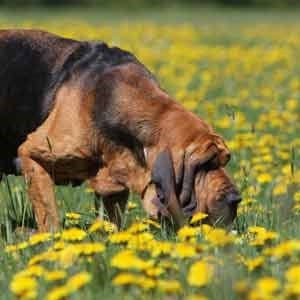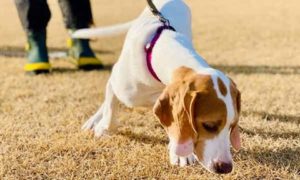It’s no secret that dogs’ sense of smell is essentially a superpower compared to our own sniffing abilities. Their noses are crucial for how dogs engage with and navigate the world around them. So, just how powerful is a dog’s sense of smell? And what all can their nose do?
Table of contents
Anatomy of sniffing
Nose
Relative to their heads, dogs’ noses are much larger than ours. This means that they have much more surface area for more sensory receptors. In fact, pups have anywhere from 100 million to 300 million olfactory receptors in their nasal cavity, while humans only have about six million. Their nasal tissues, or epithelium, are about 30 times larger than that of humans.
Jacobson’s organ
Our canine companions also have an additional olfactory organ that we humans simply do not have. The vomeronasal organ, often referred to as Jacobson’s organ is located inside a dog’s nasal cavity and opens into the roof of the mouth. Nerves from the vomeronasal organ connect directly to the brain and are unique in that they only detect “undetectable” odors—chemicals like pheromones.
This secondary olfactory system communicates with the part of the brain that deals with mating. With this, male and female dogs can determine if other dogs are available for breeding. Jacobson’s organ also helps newborn puppies find their mother’s milk source and identify their mother among other female adult dogs. As if this wasn’t impressive enough, pups also have heat sensors in their noses that help them locate their mothers.
A dog’s nose and Jacobson’s organ work together to sniff out an amazing amount of information that they can use better understand their environment at any given time. You may be able to tell when a dog is engaging their Jacobson’s organ—they expose their nasal cavity to an immense amount of odor molecules by curling their lips and flaring their nostrils.
Brain
The area of the canine brain that is dedicated to analyzing and processing scents is proportionally about 40 times larger than that of humans. It’s no wonder they can smell so much more than we can!
Nostrils
Dogs’ noses, all the way down to even the shape of their nostrils, are designed to be far more efficient and powerful than ours. Canines can operate their two nostrils independently of one another. This means that they can determine the direction from which an odor is coming and use their sense of smell like a compass to follow and locate the source of an odor.
Because a dog’s inhaled air is directed through two different passages—one for breathing and one for smelling—dogs can breathe and sniff at the same time. They are constantly and simultaneously processing oxygen and odors through two independent systems. What’s more, their nostrils are designed in such a way that exhaled air pushes even more odor molecules into their noses. With this, dogs can sniff pretty much continuously.

Sense of smell: Dogs vs. humans
It’s amazing just how powerful dogs’ snouts are, especially when compared to human noses. While we’re observing the world with our eyes, our dogs are learning even more just by sniffing. Experts estimate that depending on the breed, pups can smell tens of thousands of times better than people can. And while we can detect between 4,000 to 10,000 different smells, dogs can distinguish as many as 100,000.
According to experts, our canine companions can detect some odors in parts per trillion. To put that in perspective, while humans may be able to notice a teaspoon of sugar in their cup of coffee, a dog would be able to detect that single teaspoon in a million gallons of water, or two Olympic swimming pools.
While all dogs put human noses to shame, some breeds are known to have a stronger sense of smell than others. Breeds with superpowered snouts include:
- Bloodhounds
- Beagles
- German Shepherds
- Dachshunds
- Basset Hounds
- English Foxhounds
- Labrador Retrievers
- Coonhounds
- Golden Retrievers
- Scottish Terriers
- Belgian Malinois
- Pointers
- Springer Spaniels
Importance of sniffing
A dog’s sense of smell is central to how they navigate their surroundings and interact with the people and animals they encounter. In fact, dogs’ senses of smell are so adept that those who go blind have much less difficulty adapting to their loss of vision than humans would in the same situation. Sniffing is a primary way dogs are able to find out about the environment and what and or who it might contain—and if it’s safe.
Ever wonder why your pup goes potty in certain places? Dogs like to relieve themselves in places that already smell like a doggy bathroom. They can sniff out who has already been there and add their own scent to “mark their territory.” This can explain why potty training has the potential to be difficult when your little one—or other dogs in the house—leaves scents where they aren’t supposed to. It’s important to use special enzyme cleaners that eliminate smells. Otherwise, the scent and potty accident habit will stick.
You may notice that while on walks, your beloved pooch can’t help but sniff everything in sight. Some pet parents find this frustrating, concerned that stopping to smell the roses is hindering them from getting the benefits of a brisk walk around the block. However, a chance to sniff fulfills a major part of our dogs’ sensory needs. Nose work stimulates and exercises our dogs mentally just as much as physical exercise and play do. For active, excited dogs, time spent sniffing can take the edge off and give them an outlet for their pent-up energy.
For dogs, sniffing is simply enjoyable. In the same way, we’re able to take pleasure in seeing the world around us, dogs take joy in using their nose to sniff out all the new and interesting smells. In fact, the act of sniffing can lower a dog’s stress levels. For worried, anxious, or reactive dogs, sniffing can help give them the most information about their surroundings possible, so they feel more secure and confident.
What a dog’s nose knows
There is an extensive list of things dogs can do with their powerful noses. Not only are dogs able to sniff out more odors in greater detail than we can, but they can also detect direction, meaning they know which way a person or animal was traveling when they passed through a specific location. Based on the strength of a particular scent as it diffuses into the air, a dog can determine when someone or something passed and where they went.
Dogs also have a fantastic scent memory, so they can identify people and animals they haven’t seen in years. We already mentioned that they can smell seemingly odorless scents like pheromones, but they can also sniff out fear, anxiety, happiness, and even pregnancy based on our hormones.
It’s not just the chemicals of people and animals that dogs can detect. Canines are given all kinds of important jobs that utilize their unmatched snouts. Dogs are known to be trained to:
- Detect cancer (melanoma, colorectal, ovarian, breast, bladder, lung, prostate)
- Alert diabetes (high and low blood sugar levels)
- Detect malaria, COVID-19, and other diseases
- Anticipate epileptic seizures and narcoleptic events
- Predict migraines
- Hunt truffles and prey animals
- Detect insects and pests (termites, bed bugs, moths, rodents, etc.)
- Search and rescue
- Law enforcement and military service (bombs, drugs, cadaver dogs, other evidence, and suspect tracking and identifying)
- Detect allergens (peanuts, soy, gluten, etc.)
- And more—pretty much anything you can think of, a dog can be trained to sniff out!

Nose work and play
Scent work and nose games can exhaust your dog just as efficiently as hard physical exercise. And giving your pup opportunities to use their snouts will satisfy their natural instincts and support their overall health and happiness. There are tons of fun activities you can do with your dog to encourage them to flex their sniffing muscles:
- Snuffle mats and puzzles – Put treats or kibble in boxes, towels or blankets, shaggy bathmats or “snuffle mats,” muffin tins, or other toys and puzzles. Your dog will hunt down every last snack, working hard, keeping themselves entertained, and getting rewarded all at the same time!
- “Find it” hide-and-seek games – Whether it be sprinkling treats on the floor in front of you, around the house, or throughout the backyard, there are endless possibilities for sending your dog on a search mission. You can also hide snacks under cups or ask your pup to “pick a hand.” They’ll love the hunt for food, and you’ll love to see your furry friend so happy—and eventually, tired.
- Sniffing walks – Don’t get us wrong—physical exercise is great. Both pet parents and pooches love a good long walk that gets the heart rate up. But have you ever tried letting your dog take the lead? Every once in a while, it can be incredibly enriching to let sniffing dogs sniff. Try following your dog on a walk through the neighborhood instead of the other way around or let them roam free in the woods or open space (only if they can be trusted off-leash).
Any health or medical information in ElleVet blogs is from a variety of public and reputable sources. This information is intended as an educational resource only is not a substitute for expert professional care.












